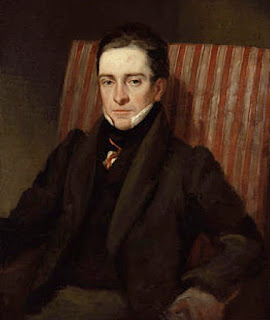Mr and Mrs Cameron.
Dearest Emily,
On today's post, let's start introducing the Characters. Above you will see Julia Margaret and Charles Hay. As you know, Julia lived at Dimbola Lodge and was a pioneering Victorian photographer. She first picked up a camera ( as legend goes ) when her daughter gave her one as a present, aged 48. Husband Charles had departed to check on his ailing Coffee plantations, and various children were being sent off to school.
Julia began what was to be her lifelong obsession at a time when few had mastered the process. Lord Somers ( her brother-in-law ) was respected for his efforts though he was to persue a parliamentary route. Oscar Reijlander and David Wylkie Winfield assisted Julia's practical learning of her craft- and her first supervised session was with Reginald Southey and Charles Dodgson in 1857 when they photographed the Tennyson boys. This particular photographic session was to lead to Dodgson feeling aggreived and insulted, but that I'll go into more in the book Emily. The purpose of this post is to start to show you who is who in 'Alice Through the Looking Glass'.
Julia was described as an energetic, eccentric, excitable and slightly comic. She had an 'unusual power of enjoying herself and making others do the same' Physically she was described as 'short and stout' with a loud low and husky voice. She was known for rushing around, running after people, hat-less and with shawls training. Her attitude to photography was to go at it like a 'bull in a china shop' in complete contrast to Dodgsons fastidious bachelor ways, creating pin-sharp images. Julia was not one to take criticism lying down, or to hold a grudge. She famously argued with Ruskin, and thumped him on the back, then ran after him red-bonnet flailing to continue the discussion. They later returned arm-in-arm.
Dodgson certainly did not care for her style of photography, though he did allow her to photograph him. She was always referred to as wearing long trailing shawls, held together by cameos.
In 'Through the Looking Glass' we meet the White Queen ( who at the end of the book morphs into both the Red and White Queen, which is explained later as the cat playing two parts ) she is introduced thus:-
'She caught the shawl as she spoke....in another moment the White Queen came running wildly through the wood....it would have been better, as it seemed to Alice if she had got someone else to dress her,she was so dreadfully untidy.."It can't go straight if you pin it to one side"..."dear me, what a state your hair is in"...'
And the Red Queen:-
'it takes all the running you can do, to keep in the same place...."Speak in French when you ca'n't think of the English for the thing- turn out your toes as you walk- and remember who you are!"
Julia and her sisters were remarked upon as frequently lapsing into French in their conversations.
John Tenniel, who had 'reluctantly agreed' to illustrate 'Looking Glass' said of himself that he only had to see a picture or person once in order to draw their cariacature.
Charles Hay Cameron ( described by Tennyson as 'A philosopher with his beard dipped in moonlight' ) was a semi-invalid by the time the Cameron's came to Freshwater. He spent most of his time either reading in the garden ( in his purple dressing gown ) or huddled up in blankets in a chair. The rest of the time he spent sleeping ( probably due to the effect of opiates that numbed his pains. ) A recluse, and Julia was known to bring people up to his bedroom and show them the sleeping Charles declaring " Behold, is that not the most beautiful old man you have ever seen?"
"It's only the red king snoring" said Tweedledee "Come and look at him...Isn't he a lovely sight"
And so my dear Emily, we begin to re-introduce the characters and who they were. More on Tweedledee, Tweedledum, and 'The Walrus and the Carpenter' next time.
Lots and lots of love,
GiGi xxx
( sources for reference include Colin Ford and Graham Ovenden and are credited fully in the manuscript of the book )














